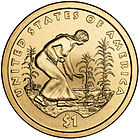One dollar coin (United States)
The dollar coin (English dollar coin ) is a coin of the United States with a value of one US dollar . It is rarely used in daily payment transactions; the 1 dollar bill is the more common means of payment.
history
In 1785 the "dollar" was used as the new currency of the USA; The first coins were issued in 1787. The American Coinage Act of 1792 declared the “Spanish dollar or peso ” with a silver weight of 371.25 grains or the equivalent of 24.056 g as the main currency unit. The first dollar coins minted in the United States itself were the so-called flowing hair dollars , they showed the profile of Miss Liberty with flowing hair. In 2013 such a coin was auctioned for 10 million US dollars, the highest amount ever paid for a coin.
The following regular dollar coins have been minted since 1794:
- Flowing Hair (1794-1795)
- Draped Bust (1795-1804)
- 1804 silver (1804)
- Gobrecht (1836–1839)
- Seated Liberty (1836–1873)
- Gold (1849–1889)
- Trade (1873-1885)
- Morgan (1878-1904; 1921)
- Peace (1921-1935)
- Eisenhower (1971–1978)
- Anthony (1979-1981; 1999)
- Sacagawea (2000-)
- Presidents (2007-2016)
- American Innovation (2018 – Probably 2032)
The dollar in circulation
Two different 1 dollar coin series are currently in production. On the one hand, there is the Sacagawea dollar , which was issued for the first time in 2000 and since 2009 has had special, annually changing motifs in honor of the Native Americans ("Native American $ 1 Coin"); the other is the American Innovation Dollar series, which started in 2018 and is expected to be completed in 2032. These two dollar coin series, like the presidential dollar series issued from 2007 to 2016 , are gold-colored. This is due to a special mixture of different metals, although it does not contain gold. These coins have the same "electromagnetic signature" as the previous Susan B. Anthony dollar (SBA dollar), which was silver in color. This coin was very similar to the Quarter in terms of color and size, which often led to confusion. Since this coin was rather unpopular, the 1 dollar bill remained the more common means of payment. The minting of this coin was discontinued in 1980, but special mintings followed in 1981 and 1999. Although this coin is rarely in circulation these days, it is still considered a means of payment.
Technical specifications
The Eisenhower dollar consists of two layers of copper-nickel (75% Cu, 25% Ni) with a layer of pure copper in between . The copper layer is visible as a red line on the edge. With a diameter of 38.1 mm and a weight of 22.68 g, the coin was rather unwieldy and was rarely used in daily payment transactions.
In 1979 it was replaced by the smaller Susan B. Anthony dollar, which consists of two layers of copper-nickel (75% Cu, 25% Ni) with a layer of pure copper in between. The copper layer is also visible as a red line on the edge. It has a diameter of 26.5 mm, a thickness of 2.0 mm and weighs 8.1 g. The edge is fluted.
The Sacagawea dollar, the President dollar and the American Innovation Dollar consist of a copper core and a coating made of a manganese-brass alloy. This alloy gives new coins a golden sheen, but tends to tarnish . The weight proportions (based on the whole coin) are 88.5% copper , 6% zinc , 3.5% manganese and 2% nickel . The coins weigh 8.1 grams with a diameter of 26.5 millimeters and a thickness of 2 millimeters. For coin-operated machines, they are identical to the Susan B. Anthony dollar.
Investment coins
The Silver Eagle is a silver coin with a face value of one US dollar . The Silver Eagle is one of the investment coins and is not used in daily payment transactions. It is the largest and heaviest silver coin in the United States. The first Silver Eagle was launched in 1986, and new editions have been published annually to this day. When it appeared, the Silver Eagle was the United States' first pure silver coin.
Individual evidence
- ↑ Unique silver coin brings in ten million dollars. In: Spiegel Online. January 25, 2013, accessed December 11, 2014 .
- ↑ United States Mint, American Innovation $ 1 Coin Program
- ↑ US Mint: Dollar Coin FAQ (Engl.)







